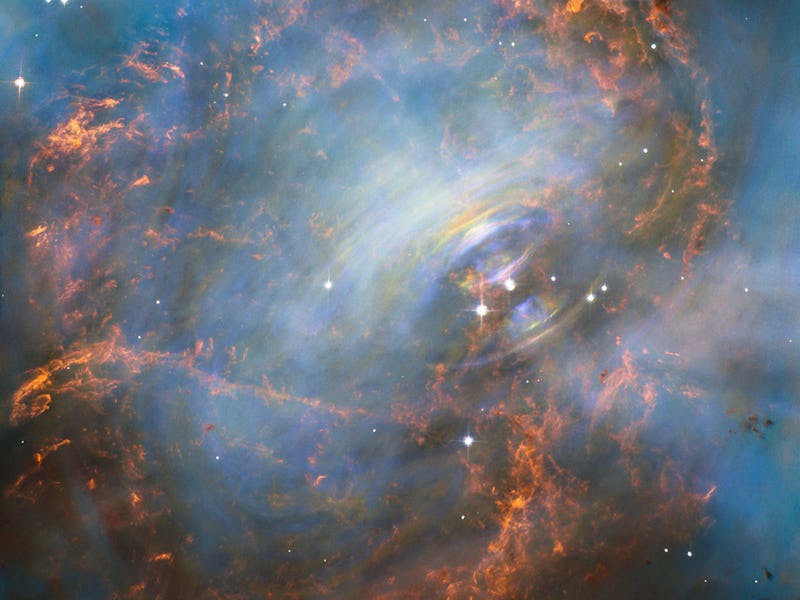Scientists uncover chemical mystery behind unique Crab Nebula supernova
A new study hints at a secret ingredient in the recipe for these beautiful cosmic cataclysms.

In 1054, Chinese astronomers noticed an incredibly bright, new star in the sky. So bright, in fact, that it was visible during the daytime.
This was no ordinary star, or, indeed, a star at all. Rather, it was an explosion caused by the violent death of a star, some 6,500 lightyears away from Earth. Incredibly, the remnants of this cataclysm — Crab Nebula — are still visible today in the constellation Taurus.
Now, for the first time, scientists have pieced together the last moments of the star that birthed this stunning nebula, finding that a strange chemical reaction may have been the trigger for the star's collapse.
As its name suggests, the Crab Nebula looks sort of like a gigantic, cosmic crab. Stretching 6 light years across, the nebular is a popular target for astronomers, both academic and amateur.
But until now, the origins of the supernova had been a mystery. A recent study, published in The Astrophysical Journal, retraces the origins of supernovae of massive stars like the one that resulted in the Crab Nebula in unprecedented detail. Its results suggest that the Crab Nebula may owe itself to the unique effects of a single chemical element, neon, on a star's core.
Essentially, neon inside massive stars appears to eat away at electrons in the stars’ cores. This cannibalistic process, known as electron capture, eventually leads to the collapse of the star — and a giant supernova.
An artist's interpretation of the electron capture process that leads to a star's collapse, for some reason visualized as an electron eating football fish that symbolizes neon.
Solving supernovae mysteries
Seeing a supernova from Earth is a rare occurrence, but on a cosmic scale, these massive explosions are much more commonplace than you might think. Every second, a star dies in the vast universe.
As it nears death, stars run out of fuel and collapse under the weight of their own gravitational force. This is a supernova.
Each supernova is unique, depending on the mass and properties of the dead star, like a cosmic snowflake. And the Crab Nebula's eye-catching shape makes it stand out from the rest.
In the new study, the team of researchers looked at the supernovae origins of giant stars that are 8 to 10 times the mass of our Sun. The mass of the Sun is measured as 1.989 x 10^30 kilograms, which is about 333,000 Earths.
Supernovae from stars this large have some distinct features. They often result in the birth of a small neutron star, for example.
The Crab Nebula has been visible in the skies for nearly 1000 years, and it is still going strong.
But looking to the stars' cores provides more detail as to their characteristics, and their origins. Stars of that mass have cores composed of oxygen, magnesium, and neon. A large number of electrons also crowd the stars’ cores, helping it maintain a high-enough energy level to keep the cores stable.
Previous studies have found that once the density of one of these stars' core is high enough, then magnesium and neon start eating away at the electrons.
But scientists were unsure what role electron capture played in prompting these stars' supernovae.
To help settle the debate, the researchers on the new paper studied a star that’s around 8.4 times the mass of the Sun, and ran a computer simulation of the star’s core evolution over time.
As magnesium and neon ate away at the electrons, the star’s core began to rapidly shrink.
The electron capture process also released heat. As the temperature increased, protons in the star began to escape from its core, making the electrons easier prey, according to the study.
That cyclical process eventually leads to the collapse of the star in a giant supernova, and the birth of a neutron star.
The Crab Nebula explained
This same electron-capture process may have been culprit that led to the Crab Nebula supernova — the remnants of which remain visible nearly 1000 years after it first blew.
The Crab Nebula has a rapidly spinning neutron star at the center. The remnants of the giant supernova continues to stretch out and expand into the universe.
This time-lapse movie of M1 was created from a series of 10 Hubble exposures. It reveals wave-like rings expanding outward from the nebula’s pulsar (the bright object just below the center of the image).
The star ejects two beams of radiation, making it seem like the neutron star is pulsing at a rate of 30 times per second. A slew of electrons also spin around the star's magnetic field lines at nearly the speed of light, producing the faint, blue light at the center of the Crab Nebula.
Scientists have observed plenty of supernovae, but even with forensic studies like this one shedding light on the process that births them, the true lead-up to these cosmic events remains largely a mystery. Modern-day researchers have never directly observed the process that a star goes through before it explodes, after all.
Late last year, the infamous star Betelgeuse gave astronomers a tiny speck of hope of doing just that. In December, 2019, it began to dim unexpectedly, leading some to believe that it was on the verge of a massive explosion right before our eyes. But Betelgeuse disappointed its captive audience when it started regaining its brightness earlier in February. We will just have to wait for another star to show failing vital signs before we can truly say how these cosmic cataclysms really go down.